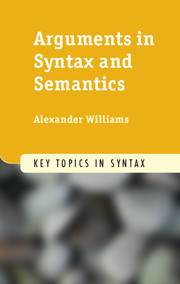Book contents
- Frontmatter
- Dedication
- Contents
- Acknowledgments
- List of abbreviations
- Introduction
- Part I Background
- Part II Kinds of arguments
- Part III Analysis of argument relations
- 6 Thematic relations
- 7 Agent and Patient
- 8 Role iteration
- 9 Separation
- 10 Event structure
- 11 Linking and framing
- Part IV Case studies
- Glossary
- References
- Index
11 - Linking and framing
Published online by Cambridge University Press: 05 January 2015
- Frontmatter
- Dedication
- Contents
- Acknowledgments
- List of abbreviations
- Introduction
- Part I Background
- Part II Kinds of arguments
- Part III Analysis of argument relations
- 6 Thematic relations
- 7 Agent and Patient
- 8 Role iteration
- 9 Separation
- 10 Event structure
- 11 Linking and framing
- Part IV Case studies
- Glossary
- References
- Index
Summary
INTRODUCTION
A dependent occupies a syntactic relation, and binds a semantic relation. We say the one relation links to the other. In a transitive clause with smack, subject and object link to relations under the rubrics of “Agent” and “Patient,” for instance. Meanwhile a predicate occurs in some frames but not others, a frame being a particular constellation of dependents. Smack can occur in a transitive frame with an Agent subject and a Patient object, for example, but not in an intransitive frame with just a subject naming what got smacked. Generalizations about patterns in linking (Section 11.2) and framing (Section 11.3) are the topic of this chapter.
LINKING
11.2.1 Introduction
Linking generalizations (Carter 1976) say what sorts of semantic relations go with what sorts of syntactic relations. All the sentences in (1) report on some kind of striking, and in each it is the subject that names the striker, and the object that names the struck. Beginning here, and throughout the remaining chapters, I will for convenience refer to these surface relations, subject and object, with the abbreviations S and O.
(1) a Nik smacked the table.
b The mule kicked Otis.
c Rocky punched the beef.
In English we do not find the reverse, active transitive clauses whose event is a striking, but where O names the striker and S names the struck. These would look like the items in (2), imagining these to be synonymous with their counterparts in (1).
(2) a * The table schmacked Nik.
b * Otis schkicked the mule.
c * The beef schpunched Rocky.
Only rarely does any language even seem to exhibit the linking in (2) – these being the apparently “deep ergative” languages such as Dyirbal (Dixon 1994) – and the analysis of such languages is in every case highly controversial. More importantly, I know of no language where some verbs of striking exhibit pattern (1), and others, pattern (2).
- Type
- Chapter
- Information
- Arguments in Syntax and Semantics , pp. 233 - 270Publisher: Cambridge University PressPrint publication year: 2015

